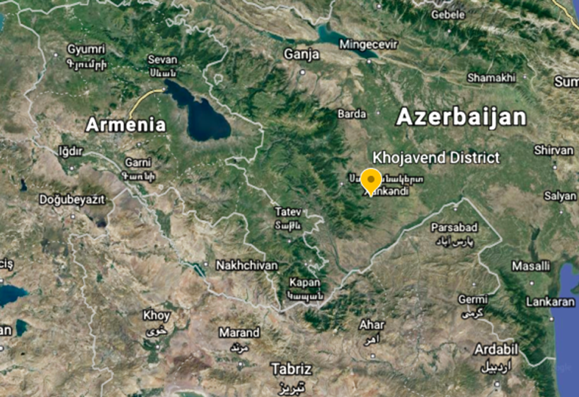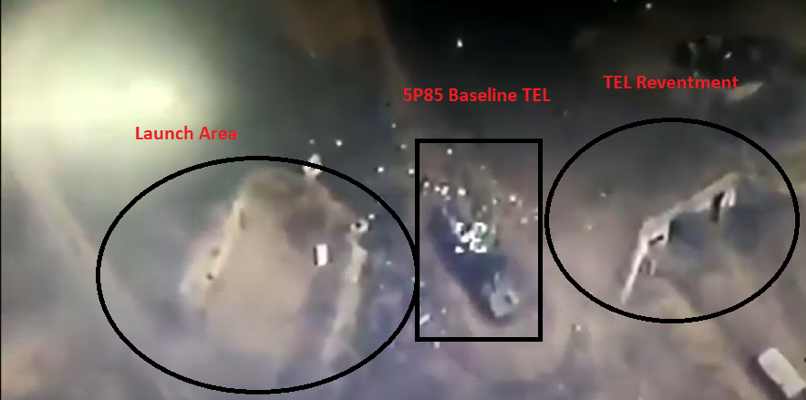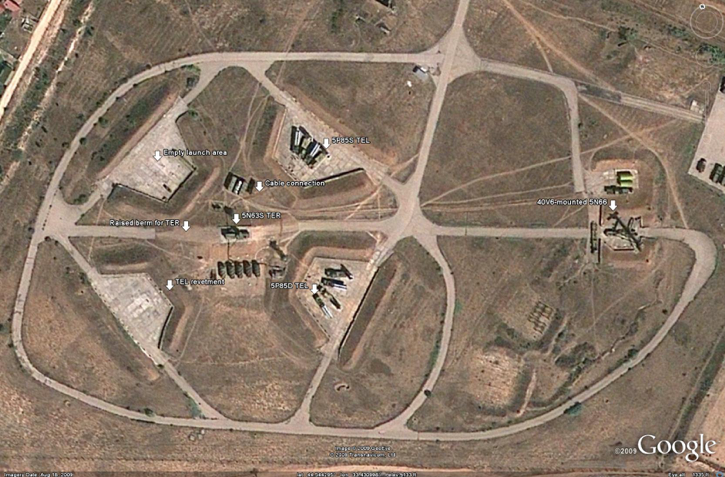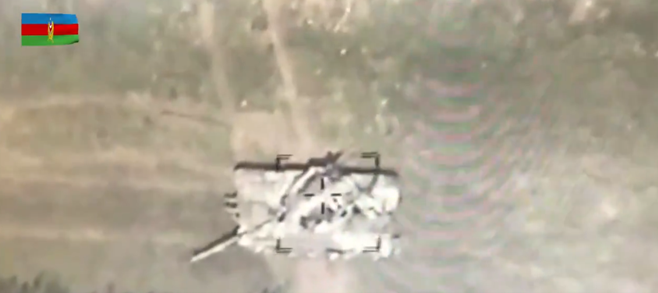THE HUNT FOR ARMENIA’S S-300:
ASSESSING AZERBAIJAN’S MOST SENSATIONAL SAM SYSTEM HIT IN THE
ONGOING WAR
Dr. Can Kasapoglu, Director of Security & Defense Research Program, EDAM,
Sine Ozkarasahin, Researcher, EDAM
Location of the reported Armenian S-300 SAM Site
What Happened?
- On September 29, 2020, several press sources claimed that Armenia had started relocating some of its S-300 SAM systems from the capital to the combat frontier. Following this move, the Azerbaijani Ministry of Defense firmly stated that they would destroy the system once it enters the Armenian-occupied Nagorno-Karabakh region[1].
- On September 30, 2020, the Azerbaijani military announced that they destroyed an Armenian S-300 in Nagorno-Karabakh, specifically in Shuskakend, the Khojavend district[2]. The district in question lies along the line of contact in Karabakh, located near the town Fizuli. Fizuli, since the outset of the conflict, has loomed large as the hot zone of the Armenia – Azerbaijan bonanza. Armenian authorities have denied Azerbaijan’s claims.
Open-Source Intelligence Assessment
- The leaked video of the reported S-300 strike, from which the visual evidence is shown below, does not have the best resolution compared to the Azerbaijani military’s other uploads. Nevertheless, although it is a low-resolution input, we have two important open-source intelligence pieces suggesting that Azerbaijan indeed infiltrated into an Armenian SAM site and attacked at least one S-300 battery.
- The first evidence remains the setting, suggesting a textbook Soviet-school SAM site with a transporter-erector-launcher (TEL) revetment, a launch area, and other characteristic features. Second, there is the vehicle in the target cursor what appears to be a 5P85-baseline transporter-erector-launcher, the standard TEL for the S-300 baseline.
The open-source visual from the Azerbaijani military’s strike on the Armenian S-300
S-300PS SAM Site near Sevastopol as an example of Soviet-Russian SAM site configuration[3].
 S-300 Baseline 5P85 Transporter-Erector-Launcher
S-300 Baseline 5P85 Transporter-Erector-Launcher
- At this stage, few issues also loom large to iron-out an objective analysis as to the S-300 case.
- First, some could question, why there was no blast effect in the reported S-300 strike upload. A plausible explanation would be related to the Azerbaijani weapon of choice to execute the mission. While traditional unmanned aerial systems, like the Bayraktar TB-2, launch their combat payload onto their targets, loitering munitions (kamikaze drones), like the Israeli Harpy & Harop line, are combat payload themselves carrying warheads attached to them and directly homing onto their prey. Since the outset of the war, this has been a very distinctive feature in the videos uploaded by the Azerbaijani Ministry of Defense that identifying whether the Armenian platform was hit by a traditional drone or a kamikaze one. With the latter, the video stops before the blast took place.
- Second, one could ask why the Azerbaijanis preferred the Israeli-manufactured Harpy / Harop for the S-300 hunt.
- The Azerbaijani military has actively resorted to drone warfare during the ongoing clashes. While Turkey’s Bayraktar TB-2, along with Roketsan-manufactured smart munitions, have dominated the battlefield so far, recently, open-source visuals also suggest the use of Baku’s Israeli-made kamikaze drones[4]. The Israeli-made Harop (Harpy 2) loitering munitions are natural SAM system hunters due to their anti-radiation features and high-level autonomy. The Harpy baseline, as indicated by its makers, “detects, attacks and destroys enemy radar emitters, hitting them with high hit accuracy”[5].
- Most probably, the design philosophy behind the Israeli-manufactured kamikaze drone made it the weapon of choice for the S-300 mission. The maximum speed difference between the Harop (225 knots max.) and the Bayraktar TB-2 (70knots cruise / 120knots max.)[6] could be another factor as the Azerbaijani military knew that it had to infiltrate into a critical SAM site rapidly.
- Nevertheless, because it was the most sensational hit of the Azerbaijani military throughout the ongoing war, one can still claim that the absence of a second platform for performing battle damage assessment and collecting information warfare pieces would be a negative line on the operation’s score-card.
- Another explanation could be related to the details of the operation. Infiltrating into the engagement envelops of a critical SAM site, even with unmanned systems, is a very hard task despite drones’ low radar signature. Thus, an alternative scenario could be the downing of an accompanying Azerbaijani unmanned platform (or platforms), which was tasked with battle damage assessment over the target area, after the first Azerbaijani anti-radiation drone hit the S-300.
Azerbaijani Loitering Munitions targeting an Armenian main battle tank in the frontier
Political-Military Assessment
- The Azerbaijani military’s strike to destroy the Armenian frontline-deployed S-300 is of utmost importance for a number of political-military reasons. First, some experts suggest, Armenia’s offensive and defensive strategic weapons (SS-26 Iskander tactical ballistic missiles and S-300 strategic SAM variants) fall under the Russo – Armenian Joint Group of Forces (established back in 2016 and activated in 2017). This very plausible assumption, if correct, draws strong lines between the S-300 incident and the Russian military presence in the Caucasus. In any case, Armenian defense planners cannot combat-deploy a strategic SAM system to the Nagorno-Karabakh frontier without Russian consent.
- The Armenian Air Force has very limited combat capabilities with only one squadron of Su-25 attack aircraft (14 platforms before the September 2020 clashes), a limited number of Mi24K Hind gunships, and four L-39 Albatros and ten Yak-52 training aircraft[7]. Although it was claimed that Yerevan received an unspecified number of Su-30s from Russia in late 2019, it is not clear whether the Armenian Air Force actually gained such a capability or not. Overall, the Armenian Air Force’s capabilities are weak and its doctrinal order of battle is designed to provide close air-support to the ground units against the Azerbaijani formations along the line of contact.
- While the air force remains underdeveloped, Armenian military leadership keeps the country’s air defenses at high-alert in an effort to compensate for the air-to-air warfare shortfalls. Open-source surveys report that Armenia deploys at least four S-300 strategic SAM system divisions which form the backbone of the country’s long-range / high-altitude air & missile defense deterrent. The SAM posture and its command & control structure are linked to the Russian forward-deployed contingent in Gyumri, centered on the 102nd The Russian Aerospace Forces’ Mig-29 fighters are a part of Armenia’s broader defenses. Especially, back in 2015, following the Turkish Air Force’s downing of a Russian Su-24 near Syria –violating the Turkish airspace–, Moscow and Yerevan have intensified their airspace control measures[8]. In addition, Yerevan and Moscow signed a joint air defense deal back in 2016. Since then, airspace control coordination between the two countries has speeded up. At present, the Russian contingent enjoys almost full control over the Armenian air and air defense operations, especially at higher echelons. This control extends to the SAM-centric air defense of Armenia, married to the Russian SAM composition in the 102nd base, as well as the forward-deployed Mig-29 air-wing of the Russian Aerospace Forces.
- Against the backdrop of the aforementioned factors, Azerbaijan’s targeting of the Armenian S-300 strategic SAM was both a political-signaling and a military measure. Politically, it sent a message to Moscow that this time Baku, backed by Turkey, will not settle for a limited punitive operation. Militarily, Azerbaijani defense planners opted for preventing an Armenian anti-access / area denial bubble emerging in the frontier area that could disrupt the air campaign.
[1] Anadolu Agency, “Armenia moving S-300 missile systems to border areas”, https://www.aa.com.tr/en/asia-pacific/armenia-moving-s-300-missile-systems-to-border-areas/1989996, 29 September 2020, accessed: 30 September 2020.
[2] Sputnik, “Azerbaijani Defence Ministry Claims to Have Destroyed Armenian S-300 in Nagorno-Karabakh”, https://sputniknews.com/world/202009301080616963-azerbaijani-defence-ministry-claims-to-have-destroyed-armenian-s-300-in-nagorno-karabakh-/, 30 September 2020, Accessed: 30 September 2020.
[3] Sean O’Connor, Soviet/Russian SAM Site Configuration, Air Power Australia, http://www.ausairpower.net/APA-Rus-SAM-Site-Configs-B.html, Accessed on: October 1st, 2020.
[4] Azerbaijan MoD, https://twitter.com/wwwmodgovaz/status/1311132895004831745, Accessed on: September 30, 2020.
[5] IAI Harpy, https://www.iai.co.il/p/harpy, Accessed on: September 30, 2020.
[6] IAI Harop, https://www.iai.co.il/p/harop, Accessed on: October 1st, 2020; Baykar Bayraktar TB-2, https://baykardefence.com/uav-15.html, Accessed on. October 1st, 2020.
[7] IISS, Military Balance 2020, 2020.
[8] For a detailed assessment of the Armenian Air Force, see. IHS Jane’s, Armenia – Air Force, 2017.







